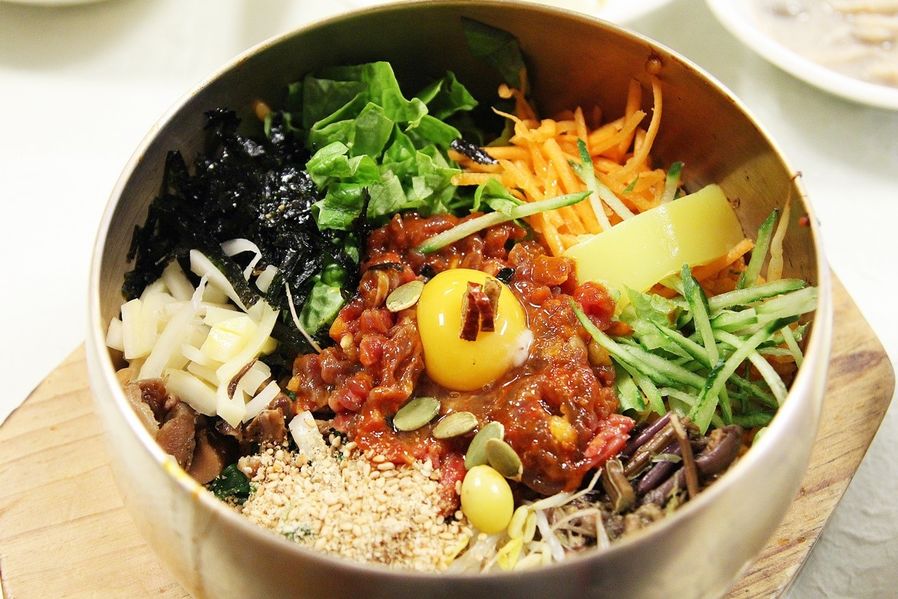1. Ingredients for Bibimbap
- Primary ingredients: Cooked white rice
- Secondary ingredients: Seasoning (Gochujang paste and sesame oil), vegetables (bean sprout, cucumber, carrot and lettuce) and greens (balloon flower, bracken and mushroom)
2. Taste evaluation
-Spicy: ★★★☆☆
-Salty: ★★☆☆☆
-Sweet: ★★☆☆☆
-Sour: ☆☆☆☆☆
3. Introduction to Bibimbap
Bibimbap is world-widely known as one of Korean foods that it is even served on various airplanes. Bibimbap refers to rice mixed with various vegetables, stir-fried meat and spicy Gochujang paste in a big bowl. It became more popular as Michael Jackson mentioned that he used to enjoy this food.
Bibimbap currently is so famous but the history goes back 200 years ago since the 1800s. It has a short history but people started to love it as it is simple and delicious.

You will find many different kinds of Bibimbap cooked in different ways. At home, Korean people simply mix rice, Gochujang paste and a couple of dishes. However, there is a secret to a bowl of decent Bibimbap.
First of all, rice should be cooked with proper amount of water to be hard-boiled rice. You also need two or three dishes of greens sun-dried long enough, two or three fresh seasonal vegetables and marinated (salty) meat.
The seasoning would be sesame oil and Gochujang paste that has various flavors.
Gochujang paste is Korean traditional sauce that is made from spicy chili powder. Chili powder is mixed with fermented beans (blocks of fermented soybeans), sweet malt, salt and other ingredients, and they are left to age for a long time. It is not just spicy but it also has taste of beans, sweetness and saltiness mixed altogether for a long time.
It’s not done yet. At last, Bibimbap is served in ttukbaegi(earthen pot) or heavy brass pot to keep it warm until you finish it.
You’ll taste well-cooked rice, tasty greens and crunchy vegetables mixed with spicy Gochujang paste and it would leave you a flavory aftertaste of sesame oil.
Have you heard that ‘spice’ represents Korean foods? So I suggest that you try adequately spicy Bibimbap if you ever visit Korea. Once it’s served, enjoy the look of ingredients on the table slowly before you eat them. If you notice the efforts they put to prepare the dishes, you’ll feel that you’re served as a very important guest.
4. Kinds of Bibimbap
There
are dozens of Bibimbap depending on the cuisines and regional
products used.
Each region has its own Bibimbap like Jeonju Bibimbap, Jinju Bibimbap, Andong Bibimbap, Geoje sea squirt Bibimbap and so on.
The most popular one among them is Jeonju Bibimbap. When people say Bibimbap, they mostly mean Jeonju Bibimbap.
Crunchy
bean sprouts are served on rice made with beef broth. It’s also
served with a raw egg yolk for you to neutralize spicy taste and raw
beef is sometimes served on top instead of stir-fried beef.

5. How to enjoy Bibimbap even more
In order to enjoy Bibimbap, you’re going to have to mix all the ingredients properly. However, you might crush rice if you use a spoon for this. So please use chopsticks not to ruin it.
For starters, add ½ spoon of Gochujang paste and 1 spoon of sesame oil first and add more after you taste it. Some restaurants serve very spicy Gochujang paste. And if you put too much sesame oil, you might feel a bit bitter aftertaste so try not to put more than 1 spoon.











